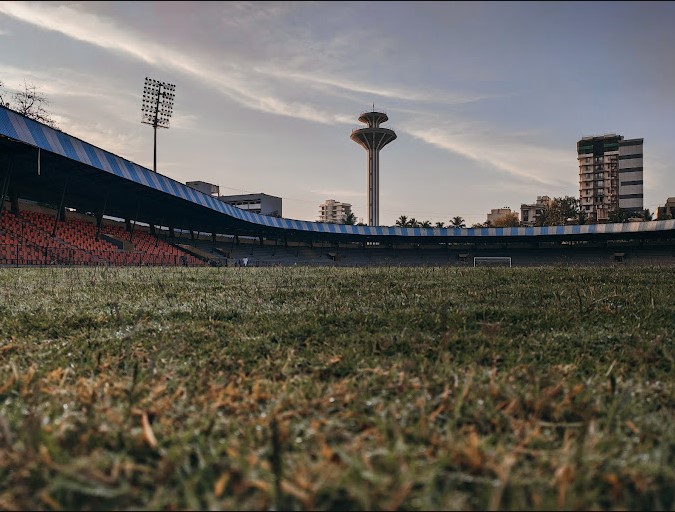Brabourne Stadium: Cricket is a sport where the dimensions of a stadium can significantly influence gameplay. Among the many iconic cricket grounds in India, the Brabourne Stadium in Mumbai holds a unique place due to its historical importance, compact size, and vibrant atmosphere. One of the most intriguing features of any cricket ground is its boundary length, and Brabourne Stadium, being smaller compared to many modern grounds, offers an interesting case study.
1. Introduction to Brabourne Stadium
Located in the heart of Mumbai, Brabourne Stadium is one of the oldest cricket grounds in India. Established in 1937, it is owned by the Cricket Club of India (CCI) and has hosted numerous international and domestic matches, including Test matches, One Day Internationals (ODIs), and Indian Premier League (IPL) games.
While modern stadiums focus on large boundaries and seating capacities, Brabourne offers a more intimate viewing experience. This compact nature directly impacts boundary lengths, often making it a favorable venue for batsmen.
2. Dimensions and Boundary Length of Brabourne Stadium
The dimensions of a cricket ground are not standardized globally, but the International Cricket Council (ICC) recommends a minimum boundary length of 65 meters and a maximum of 85 meters from the center of the pitch.
Approximate Boundary Lengths at Brabourne Stadium
| Direction | Distance from Center (Approx.) |
|---|---|
| Straight Boundaries | 65 – 68 meters |
| Square Boundaries | 60 – 62 meters |
| Fine Leg and Third Man | 58 – 60 meters |
| Long On and Long Off | 66 – 68 meters |
| Deep Mid-Wicket/Extra Cover | 62 – 64 meters |
These figures can vary slightly depending on how the boundary rope is set up for specific matches, particularly during IPL games where advertising boards and logistics may slightly adjust the rope’s placement.
3. Comparison with Other Major Stadiums
To better understand Brabourne’s scale, it helps to compare its boundaries with some other well-known Indian stadiums.
Boundary Length Comparison with Other Indian Grounds
| Stadium Name | City | Average Boundary Length (m) |
|---|---|---|
| Brabourne Stadium | Mumbai | 60–68 |
| Wankhede Stadium | Mumbai | 65–72 |
| Eden Gardens | Kolkata | 66–78 |
| M. Chinnaswamy Stadium | Bengaluru | 62–70 |
| Narendra Modi Stadium | Ahmedabad | 70–85 |
4. Impact of Boundary Length on Match Play
Shorter boundaries, such as those found at Brabourne, significantly influence gameplay in several ways:
A. More Sixes and Fours
With boundaries as short as 58–60 meters at certain points, batsmen are encouraged to take more risks. Even mistimed shots can clear the ropes, making the ground high-scoring.
B. Less Margin for Bowlers
Especially for fast bowlers and spinners who rely on flight and deception, short boundaries make it difficult to maintain control over runs. Bowlers are often forced to bowl tighter lines, which can sometimes play into the batsman’s hands.
C. Strategic Use of Field Placements
Captains and fielders need to be strategic with their placements, especially near the boundary. Misjudging a fielder’s position could turn potential catches into sixes.
5. Boundary Records at Brabourne Stadium
While the stadium does not host as many matches as larger grounds today, it has seen some explosive innings over the years.
Notable High-Scoring Matches at Brabourne
| Match Type | Team(s) | Total Score | Key Player | Boundary Stats (4s/6s) |
|---|---|---|---|---|
| ODI (2006) | India vs England | 294/6 | Yuvraj Singh | 10 fours, 5 sixes |
| IPL (2022) | MI vs RR | 193/5 | Jos Buttler | 11 fours, 5 sixes |
| Test (1969) | India vs Australia | 406/4 | Ajit Wadekar | 15 fours |
6. Audience Experience and Stadium Atmosphere
Due to its smaller size, the crowd at Brabourne is closer to the action, creating a more immersive and electrifying environment. The short boundaries enhance the crowd engagement, as every big hit feels more intense and immediate.
7. Challenges with Short Boundaries
Despite the excitement, short boundaries come with challenges:
- Safety Concerns: Balls can fly into the crowd more frequently, raising safety issues.
- Imbalance Between Bat and Ball: Purists argue that shorter boundaries skew the contest in favor of batsmen.
- Limited Expansion: The stadium, surrounded by urban infrastructure, cannot be expanded, limiting modernization potential.
8. Brabourne in Modern Cricket
Though not used as frequently for international matches anymore due to its limited seating (approx. 20,000 capacity), Brabourne remains active during IPL seasons, women’s matches, and domestic tournaments.
The boundary length of Brabourne Stadium may be on the shorter side, but this feature adds a unique charm and a fast-paced character to matches played here. In an era of towering stadiums and huge outfields, Brabourne reminds us of cricket’s more intimate, explosive side. For batsmen, it’s a paradise; for bowlers, a test of nerve and accuracy. Either way, the boundary lengths here are an essential part of the stadium’s identity and history.


